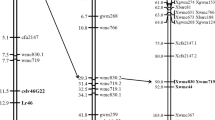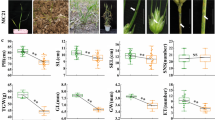Abstract
Lesion mimics (LM) that resemble plant disease symptoms in the absence of plant pathogens may confer enhanced plant disease resistance to a wide range of pathogens. Wheat line Ning7840 has adult plant resistance (APR) to leaf rust (Puccinia triticina) and shows LM symptoms at heading. A recessive gene (lm) was found to be responsible for LM in Ning7840 and located near the proximal region of chromosome 1BL using a population of 179 recombinant inbred lines (RIL) derived from the cross Ning7840/Chokwang. Genomic in situ hybridization showed that Ning7840 carries the short arm of 1R chromosome from rye (Secale cereale L.), on which the race-specific gene Lr26 resides. The RILs were infected with the isolate PRTUS 55, an isolate virulent to Lr26, at anthesis in two greenhouse experiments. The result showed that the lines with LM phenotype had a significantly higher rust resistance than the non-LM lines. Composite interval mapping consistently detected a QTL, Qlr.pser.1BL, for APR on chromosome 1BL. Qlr.pser.1BL peaked at lm and explained up to 60.8% of phenotypic variation for leaf rust resistance in two greenhouse experiments, therefore, lm from Ning7840 may have pleiotropic effects on APR to leaf rust.



Similar content being viewed by others
References
Anand A, Schmelz E, Muthukrishnan S (2003) Development of a lesion-mimic phenotype in a transgenic wheat line overexpressing genes for pathogenesis-related (PR) proteins is dependent on salicylic acid concentration. Mol Plant Microbe Interact 16:916–925
Boch J, Verbsky M, Robertson T, Larkin J, Kunkel B (1998) Analysis of resistance gene-mediated defense responses in Arabidopsis thaliana plants carrying a mutation in CPR5. Mol Plant Microbe Interact 11:1196–1206
Boyd L, Minchin P (2001) Wheat mutants showing altered adult plant disease resistance. Euphytica 122:361–368
Boyd L, Smith P, Wilson A, Minchin P (2002) Mutations in wheat showing altered field resistance to yellow and brown rust. Genome 45:1035–1040
Brodersen P (2002) Knockout of Arabidopsis accelerated-cell death 11 encoding a sphingosine transfer protein causes activation of programmed cell death and defense. Genes Dev 16:490–502
Campbell MA, Ronald PC (2005) Characterization of four rice mutants with alterations in the defence response pathway. Mol Plant Pathol 6:11–21
Chern M, Fitzgerald HA, Canlas PE, Navarre DA, Ronald PC (2005) Overexpression of a rice NPR1 homolog leads to constitutive activation of defense response and hypersensitivity to light. Mol Plant Microbe Interact 18:511–520
Dietrich R, Delaney T, Uknes S, Ward E, Ryals J, Dangl J (1994) Arabidopsis mutants simulating disease resistance response. Cell 77:565–577
Greenberg JT, Ausubel FM (1993) Arabidopsis mutants compromised for the control of cellular damage during pathogenesis and aging. Plant J 4:327–341
Greenberg J, Silverman F, Liang H (2000) Uncoupling salicylic acid-dependent cell death and defense-related responses from disease resistance in the Arabidopsis mutant acd5. Genetics 156:341–350
Guyomarc’h H, Sourdille P, Charmet G, Edwards J, Bernard M (2002) Characterization of polymorphic microsatellite markers from Aegilops tauschii and transferability to the D-genome of bread wheat. Theor Appl Genet 104:1164–1172
Hu G, Yalpani N, Briggs SP, Johal GS (1998) A porphyrin pathway impairment is responsible for the phenotype of a dominant disease lesion mimic mutant of maize. Plant Cell 10:1095–1105
Ishikawa A (2005) Tetrapyrrole metabolism is involved in lesion formation, cell death, in the Arabidopsis lesion initiation 1 mutant. Biosci Biotechnol Biochem 69:1929–1934
Ishikawa A, Tanaka H, Nakai M, Asahi T (2003) Deletion of a chaperonin 60 gene leads to cell death in the arabidopsis lesion initiation 1 mutant. Plant Cell Physiol 44:255–261
Jarosch B, Kogel KH, Schaffrath U (1999) The ambivalence of the barley Mlo locus: mutations conferring resistance against powdery mildew (Blumeria graminis f. sp. hordei) enhance susceptibility to the rice blast fungus Magnaporthe grisea. Mol Plant Microbe Interact 12:508–514
Johal GS, Hulbert SH, Briggs SP (2005) Disease lesion mimics of maize: a model for cell death in plants. Bioessays 17:685–692
Jung YH, Lee JH, Agrawal GK, Rakwal R, Kim JA, Shim JK, Lee SK, Jeon JS, Koh HJ, Lee YH, Iwahashi H, Jwa NS (2005) The rice (Oryza sativa) blast lesion mimic mutant, blm, may confer resistance to blast pathogens by triggering multiple defense-associated signaling pathways. Plant Physiol Biochem 43:397–406
Kamlofski CA, Antonelli E, Bender C, Jaskelioff M, Danna CH, Ugalde R, Acevedo A (2007) A lesion-mimic mutant of wheat with enhanced resistance to leaf rust. Plant Pathol 56:46–54
Kang SG, Matin MN, Bae H, Natarajan S (2007) Proteome analysis and characterization of phenotypes of lesion mimic mutant spotted leaf 6 in rice. Proteomics 7:2447–2458
Koebner R (1995) Generation of PCR-based markers for the detection of rye chromatin in a wheat background. Theor Appl Genet 90:740–745
Kolmer JA, Jin Y, Long DL (2007) Wheat leaf and stem rust in the United States. Aust J Agric Res 58:631–638
Kosambi DD (1944) The estimation of map distances from recombination values. Ann Eugen 12:172–175
Kosman E, Pardes E, Anikster Y, Manisterski J, Yehuda P, Szabo L, Sharon A (2004) Genetic variation and virulence on Lr26 in Puccinia triticina. Phytopathology 94:632–640
Langdona T, Seagoa C, Jonesa R, Oughamb H, Thomasb H, Forstera J, Jenkinsa G (2000) De novo evolution of satellite DNA on the rye B chromosome. Genetics 154:869–884
Lapitan N, Peng J, Sharma V (2007) A high-density map and PCR markers for Russian wheat aphid resistance gene Dn7 on chromosome 1RS/1BL. Crop Sci 47:811–818
Lee TF, McNellis TW (2009) Evidence that the BONZAI1/COPINE1 protein is a calcium- and pathogen-responsive defense suppressor. Plant Mol Biol 69:155–166
Lorrain S, Vailleau F, Balague C, Roby D (2003) Lesion mimic mutants: keys for deciphering cell death and defense pathways in plants? Trends Plant Sci 8:263–271
Lorrain S, Lin B, Auriac MC, Kroj T, Saindrenan P, Nicole M, Balague C, Roby D (2004) Vascular associated death1, a novel GRAM domain-containing protein, is a regulator of cell death and defense responses in vascular tissues. Plant Cell 16:2217–2232
Mach J, Castillo A, Hoogstraten R, Greenberg J (2001) The Arabidopsis-accelerated cell death gene ACD2 encodes red chlorophyll catabolite reductase and suppresses the spread of disease symptoms. Proc Natl Acad Sci 98:771–776
Mateos-Hernandez M, Singh RP, Hulbert SH, Bowden RL, Huerta-Espino J, Gill BS, Brown-Guedira G (2006) Targeted mapping of ESTs linked to the adult plant resistance gene Lr46 in wheat using synteny with rice. Funct Integr Genomics 6:122–131
McIntosh RA, Hart GE, Devos KM, Gale MD, Rogers WJ (1998) Catalogue of gene symbols for wheat. In: AE (ed) Proceedings of the 9th international wheat genetics symposium. 2–7 August, Saskatoon, Saskatchewan, Canada. University Extension Press, University of Saskatchewan, Saskatoon, 5
Mori M, Tomita C, Sugimoto K, Hasegawa M, Hayashi N, Dubouzet JG, Ochiai H, Sekimoto H, Hirochika H, Kikuchi S (2007) Isolation and molecular characterization of a spotted leaf 18 mutant by modified activation-tagging in rice. Plant Mol Biol 63:847–860
Nishizawa Y, Saruta M, Nakazono K, Nishio Z, Soma M, Yoshida T, Nakajima E, Hibi T (2003) Characterization of transgenic rice plants over-expressing the stress-inducible beta-glucanase gene Gns1. Plant Mol Biol 51:143–152
Penning BW, Johal GS, McMullen MD (2004) A major suppressor of cell death, slm1, modifies the expression of the maize (Zea mays L.) lesion mimic mutation les23. Genome 47:961–969
Pestsova E, Ganal M, Röder M (2000) Isolation and mapping of microsatellite markers specific for the D genome of bread wheat. Genome 43:689–697
Pilloff RK, Devadas SK, Enyedi A, Raina R (2002) The Arabidopsis gain-of-function mutant dll1 spontaneously develops lesions mimicking cell death associated with disease. Plant J 30:61–70
Rate DN, Cuenca JV, Bowman GR, Guttman DS, Greenberg JT (1999) The gain-of-function Arabidopsis acd6 mutant reveals novel regulation and function of the salicylic acid signaling pathway in controlling cell death, defenses, and cell growth. Plant Cell 11:1695–1708
Röder M, Korzun V, Wandehake K, Planschke J, Tixier M, Leroy P, Ganal M (1998) A microsatellite map of wheat. Genetics 149:2007–2023
Rogowsky P, Sorrels M, Shepherd K, Langridge P (1993) Characterisation of wheat-rye recombinants with RFLP and PCR probes. Theor Appl Genet 85:1023–1028
Rostoks N, Schmierer D, Kudrna D, Kleinhofs A (2003) Barley putative hypersensitive induced reaction genes: genetic mapping, sequence analyses and differential expression in disease lesion mimic mutants. Theor Appl Genet 107:1094–1101
Rostoks N, Schmierer D, Mudie S, Drader T, Brueggeman R, Caldwell DG, Waugh R, Kleinhofs A (2006) Barley necrotic locus nec1 encodes the cyclic nucleotide-gated ion channel 4 homologous to the Arabidopsis HLM1. Mol Genet Genomics 275:159–168
Saal B, Wricke G (1999) Development of simple sequence repeat markers in rye (Secale cereale L.). Genome 42:964–972
Saghai-Maroof MA, Soliman K, Jorgensen RA, Allard RW (1984) Ribosomal DNA spacer-length polymorphisms in barley: Mendelian inheritance, chromosomal location, and population dynamics. Proc Natl Acad Sci 81:8014–8018
Shirano Y, Kachroo P, Shah J, Klessig D (2002) A gain-of-function mutation in an Arabidopsis Toll Interleukin1 receptor-nucleotide binding site-leucine-rich repeat type R gene triggers defense responses and results in enhanced disease resistance. Plant Cell 14:3149–3162
Smith PH, Howie JA, Worland AJ, Stratford R, Boyd LA (2004) Mutations in wheat exhibiting growth-stage-specific resistance to biotrophic fungal pathogens. Mol Plant Microbe Interact 17:1242–1249
Somers D, Isaac P, Edwards K (2004) A high-density microsatellite consensus map for bread wheat (Triticum aestivum L.). Theor Appl Genet 109:1105–1114
Song QJ, Shi JR, Singh S, Fickus EW, Costa JM, Lewis J, Gill BS, Ward R, Cregan PB (2005) Development and mapping of microsatellite (SSR) markers in wheat. Theor Appl Genet 110:550–560
Sourdille P, Cadalen T, Guyomarc’h H, Snape JW, Perretant M, Charmet G, Boeuf C, Bernard S, Bernard M (2003) An update of the CourtotrChinese Spring intervarietal molecular marker linkage map for the QTL detection of agronomic traits in wheat. Theor Appl Genetics 106:530–538
Sourdille P, Singh S, Cadalen T, Brown-Guedira G, Gay G, Qi L, Gill B, Dufour P, Murigneux A, Bernard (2004) Microsatellite-based deletion bin system for the establishment of genetic-physical map relationships in wheat (Triticum aestivum L.). Funct Integr Genomics 4:12–25
Takahashi A, Kawasaki T, Henmi K, Shii K, Kodama O, Satoh H, Shimamoto K (1999) Lesion mimic mutants of rice with alterations in early signaling events of defense. Plant J 17:535–545
Walbot V, Hoisington D, Neuffer M (1983) Disease lesions mimic mutations. In: Kosuge T, Meredith CP, Hollender A (eds) Genetic engineering of plants. Plenum Publishing, New York, pp 431–442
Wang LJ, Pei ZY, Tian YC, He CZ (2005) OsLSD1, a rice zinc finger protein, regulates programmed cell death and callus differentiation. Mol Plant Microbe Interact 18:375–384
Yamanouchi U, Yano M, Lin H, Ashikari M, Yamada K (2002) A rice spotted leaf gene, Spl7, encodes a heat stress transcription factor protein. Proc Natl Acad Sci 99:7530–7535
Yin ZC, Chen J, Zeng LR, Goh ML, Leung H, Khush GS, Wang GL (2000) Characterizing rice lesion mimic mutants and identifying a mutant with broad-spectrum resistance to rice blast and bacterial blight. Mol Plant Microbe Interact 13:869–876
Yu JB, Bai GH, Cai SB, Ban T (2006) Marker-assisted characterization of Asian wheat lines for resistance to Fusarium head blight. Theor Appl Genet 113:308–320
Acknowledgments
We thank Dr. Bernd Friebe and Dr. Lili Qi from Kansas State University, Manhattan, KS, for providing GISH data and Dr. Robert Bowden from USDA-ARS Plant Science and Entomology Research Unit, Manhattan, KS, for providing the rust isolates and kind help in manuscript preparation. This project is partly funded by the NRI of the USDA CSREES, CAP grant number 2006-55606-16629. Mention of trade names or commercial products in this article is solely for the purpose of providing specific information and does not imply recommendation or endorsement by the US Department of Agriculture. Contribution No. 09-033-J from the Kansas Agricultural Experiment Station, Manhattan, Kansas, USA.
Author information
Authors and Affiliations
Corresponding author
Additional information
Communicated by J. Dubcovsky.
Electronic supplementary material
Below is the link to the electronic supplementary material.
Rights and permissions
About this article
Cite this article
Li, T., Bai, G. Lesion mimic associates with adult plant resistance to leaf rust infection in wheat. Theor Appl Genet 119, 13–21 (2009). https://doi.org/10.1007/s00122-009-1012-7
Received:
Accepted:
Published:
Issue Date:
DOI: https://doi.org/10.1007/s00122-009-1012-7




